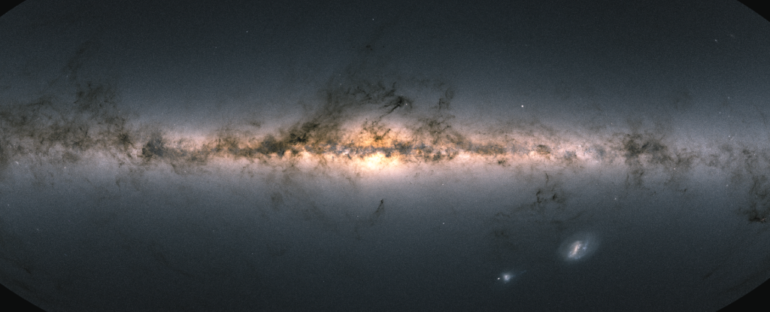The most accurate three-dimensional map yet of the Milky Way is revealing our galaxy’s secrets. Peering deep into the anticentre – the opposite direction of the galactic centre – is helping astronomers piece together the Milky Way’s wild past.
The European Space Agency’s Gaia satellite, launched in 2013, has been working for years to map the galaxy with the most detail and highest precision achievable. Its new data release, the Gaia Early Data Release 3 (EDR3), is a vast improvement on the existing data, as demonstrated in a series of new papers published in Astronomy & Astrophysics.
As well as probing the galaxy’s anticentre, astronomers have described the orbit of the Solar System around the galactic centre, taken a closer look at the Magellanic Clouds that orbit the Milky Way, and performed the largest census yet of Milky Way stars and their motion in the sky.
“The new Gaia data promise to be a treasure trove for astronomers,” said astronomer Jos de Bruijne of the ESA.
Gaia orbits the Sun with Earth, in a looping orbit around the Sun-Earth L2 Lagrangian point, a gravitationally stable pocket of space created by the interactions between the two bodies. From there, it carefully studies stars in the Milky Way over an extended period, watching to see how the positions of stars seem to change against more distant stars. This provides a parallax, which can be used to calculate the distances to the stars.
That can be done from here on Earth, but atmospheric effects can interfere with the measurements. From its position in space, Gaia has an advantage, which it has been using to great effect.
To date, it has mapped in detail 1.8 billion sources, and collected colour information on 1.5 billion sources. According to the ESA, that’s an increase of 100 million and 200 million sources from Data Release 2 in 2018.
Of particular interest is the anticentre of the Milky Way. This region isn’t as densely populated as the galactic centre, nor is it as obscured by interstellar clouds of thick dust, giving a clearer view of the stars at the edge of the Milky Way.
(ESA/Hubble, Sketch: ESA/Gaia/DPAC)
This region shows more clearly the disturbances inflicted upon the Milky Way throughout its history and, studying the new data, astronomers concluded that the galaxy’s disc used to be smaller than it is today.
Interestingly, older stars – the original population of the Milky Way – don’t extend out as far as stars from the Gaia Sausage, a galaxy that merged with the Milky Way 8 to 10 billion years ago.
When looking above and below the galactic plane, a different picture emerges. A group of stars above the plane is moving downwards, and stars below are moving up. This, according to analysis, could be the result of a slow, ongoing collision with the Sagittarius dwarf galaxy, ruffling up the outer edge of the Milky Way’s disc.
The Sagittarius galaxy, according to a paper released earlier this year based on Gaia DR2, is likely causing a warp in the Milky Way’s disc as it moves around. Its last close encounter is difficult to narrow down, but it took place between 300 and 900 million years ago, producing some strong perturbations.
Although unexpected, the odd motions of stars spotted in EDR3 could be more evidence of the ongoing interaction between the two galaxies, as determined by simulations that match the observations.

That’s not the only violence Gaia has confirmed. The Milky Way has two companions, the Large and Small Magellanic Clouds, orbiting each other as they also move around the Milky Way. Eventually, these too will merge into the Milky Way, but they’re also engaged in interactions with each other.
In the Gaia data, astronomers observed in greater detail a stream of stars called the Magellanic Bridge being pulled out of the Small Magellanic Cloud towards the Large Magellanic Cloud. They also clearly observed the spiral structure of the Large Magellanic Cloud, and found tantalising hints of previously unseen structures at the outer edges of both Clouds.
The Solar System’s motion, too, got a slight revision. By observing the motions of distant galaxies, astronomers were able to calculate the acceleration of the Solar System against the rest frame of the Universe. This has given us the first measurement of the curvature of the Solar System’s orbit around the Milky Way’s centre.
And a new census of stars within 100 parsecs (326 light-years) of the Solar System is the most complete yet. It contains 331,312 stars – an estimated 92 percent of all stars within that distance. The Gaia Catalogue of Nearby Stars should provide an invaluable benchmark for astronomy.
Based on previous Gaia data releases, we’ve learnt a great deal about our home galaxy, including some fascinating surprises, such as the largest gaseous structure in the Milky Way, hidden stellar streams from ancient collisions, and a new estimate of the size of the Milky Way (it was much bigger than we thought!).
EDR3 will expand on that knowledge, and Gaia, although nearing the end of its mission, is not yet done. EDR3 is only the first part of the data release. The second part is coming sometime in 2022.
The satellite will retire in 2022, too. But it will do so having irrevocably changed astronomy, and our understanding of the space around us.
The papers have been published in Astronomy & Astrophysics, and the data release can be found here.
